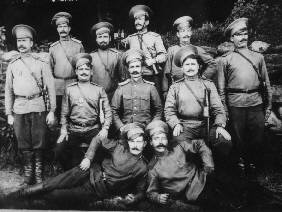| The Cossacks know how to make themselves heard. Surely,
this is largely due to the fact that they see themselves as a serious military
power with its own, effective structures. The currency of this view seems
to be supported by military operations of Cossack units or individuals within
Russia's various regions as well as outside of the "motherland's" borders,
in Moldavia or in the Kraina.
By now, Cossack units have once again been integrated
into the regular Russian army. After the Cossacks were explicitly mentioned
in the decree of the Russian president on the rehabilitation of opressed
peoples in 1991, some found confirmation of their view of the Cossacks
as a people; other see themselves as an independant ethnic/social layer
(sosloviye) with traditional military tasks in border zones. These tasks
are connected to specific cultural and economic forms as well as with
a specific moral codex.
In 1916, there were 4.4 million Cossacks. Today, the
number of Cossacks is unclear, ranging from 10 to 30 million; according
to "Moskovskiye novosti" (16, 1996, p. 4), official Cossack associations
claim that there are 25 million Cossacks at present. The Don-Army (Donskoye
voisko; Cossack communities call themselves "armies") has been and is
considered as the largest single Cossack association.
It is fighting for the establishment of a Don-Cossack
region within its historical boundaries. This territory was an autonomous
region of the Russian Empire and existed up to 1920. Today, appr. 1,5
million people who call themselves Cossacks live on the banks of the Don
and its tributaries. They place a great deal of value on their difference
to the "inogorodnye", people of "other origin". However, the latter comprise
more than two thirds of the population of the Rostov region alone. This
group views the efforts toward Cossack autonomy with a great deal of mistrust.
By far not all of those who call themselves Cossacks
today lead an agricultural or rural life. Quite on the contrary: many
of them live in urban areas and work as teachers, doctors or scientifst.
After more than 70 years of repression, the identity of the Cossacks is
largely defined by self-cosciousness and tradition. The main factor is
whether the family's ancestors were Cossaks and whether they were Russian-Orthodox.
Aside from the traditional Cossacks (rodovye kasaki), there are also "honorary"
Cossacks. Non-Cossacks are given military ranks according to their achievements.
Leading figures of the Cossack movement insist that - like before - non-Russians
can also become members of the Cossack community. The conditions for this
assimilation are a trial period and the conversion to the Russian-Orthodox
religion.
Marion
Krause
|

